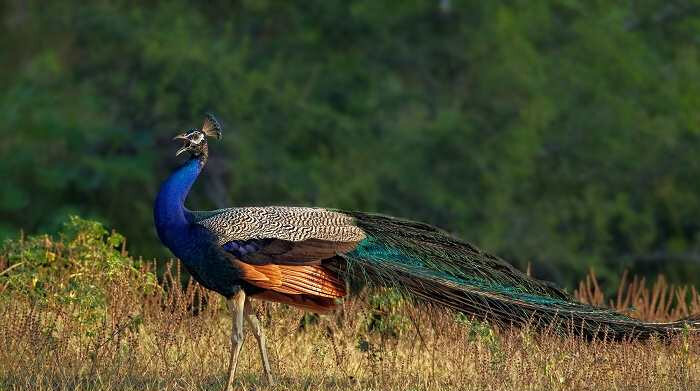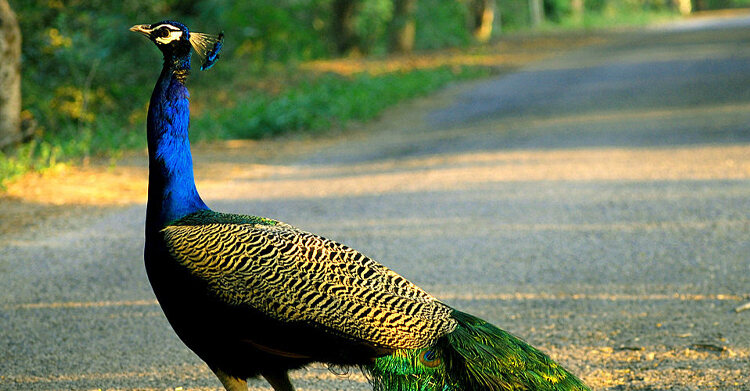Table of Contents
The national bird of India is the Indian Peafowl, commonly known as the Indian peacock, Pavo cristatus (scientific name: Pavo cristatus).
The national bird of a country is a designated representative of that country’s fauna. It is chosen on the basis of the unique qualities that the bird may symbolise. It should uphold certain core qualities or values of the nation it belongs to.
Peacock, was declared the national bird of India in 1963 due to its rich religious and cultural significance in Indian traditions. Known for its vibrant plumage and distinctive dance during the mating season, the peacock symbolises grace, beauty, and elegance in Indian folklore.

“Rashtriya Pakshi” is the Hindi term for the national bird. In the context of India, the national bird is the Indian Peafowl, commonly known as the peacock (scientific name: Pavo cristatus). The decision to designate the peacock as the national bird was made by the Indian government in 1963.
Peacocks are found all over the Indian region. It has also always been attached to our traditional history. Lord Krishna also depicted the feather of a peacock on his forehead. Peacock is also well recognised by the Indian masses. The government also uses peacock in many of the publications and it also does not coincide with any of the national birds of any other nation.
The Indian Peafowl, or peacock, proudly graces India as its national bird.
How Male and female peacock differ
Peacock’s beautiful shimmering colours made it a favourite amongst the Mughal period art and architectural motifs. This swan-sized bird has a long slender neck, white patch under its eyes and a fan-shaped beautiful array of feathers that are brightly coloured in males as blue and green-bronze feathers. They are a perpetual joy to see, especially when they spread their feathers on a cloudy day just before it rains and dance gracefully to court the females. A crown-shaped crest their head lends them a more exotic look.
However peahens (females) are smaller and are of muddy-brown colour.
The female peafowl lacks the flamboyant colours altogether. They predominantly have brownish grey colouring, and sometimes have a crest similar to the peacock but brown in colour.
Peacock: The National Bird Of India
This majestic bird symbolises the nation’s rich biodiversity and vibrant traditions.
Indian Peacock has earned the glory of being the National Bird of the biggest democracy in the world.
The peacock holds cultural and religious significance. And, is often associated with deities and considered a symbol of beauty and auspiciousness.
Why Peacock Is Our National Bird ?
The peacock was chosen as India’s national bird for its cultural, religious, and aesthetic significance. In Indian folklore, the peacock is associated with qualities such as grace, beauty, and elegance. Its striking plumage and distinctive dance during the mating season have made it a symbol of vibrant diversity.
The choice also reflects the bird’s presence in various Indian traditions and its representation of the country’s rich natural heritage. The decision to designate the peacock as the national bird was made in 1963 by the Indian government.
The Indian Peafowl, or peacock, was declared the national bird of India by the Indian government. This declaration was made in 1963.
Characteristics of the Indian Peafowl
The male peafowl, known as a peacock, is known for its vibrant and elaborate plumage, while the female, called a peahen, has a more subdued appearance. The peacock’s distinctive dance is a part of its courtship display.
Peacocks are sometimes domesticated and kept in the garden for aesthetic purposes.
Peacocks are found throughout India, especially on the south and east of the Indus River and is protected under the Indian Wildlife Protection Act of 1972. It is a crime to poach the national bird in India and is strictly prohibited.
Common Facts About The National Bird of India
The Indian peafowls do not have any specific breeding season and mating is generally dependent on rain. In south India, they mate during January to March, while in northern parts of the country they mate during late July to September.
- Scientific Name: Pavo cristatus
- Adopted in: 1963
- Habitat: Grasslands, forests, near human habitats
- Found in: Indigenous to India, Nepal, Bangladesh, Myanmar, Sri Lanka but has been introduced all over the world
- Eating Habits: Omnivorous
- Average weight: Male – 5 Kg; Female – 3.5 Kg
- Average Length: Male – 1.95 to 2.25 m; Female -upto 0.95 m
- Average Wingspan: 1.8 m
- Average Lifespan: 15-20 years in wild
- Average Speed:13 km/h
Image of the National Bird of India
Threats and Conservation
Threats towards the Indian peafowl arise due to the demand for the beautiful feathers to be used for decorative purposes. They are hunted and killed by poachers
Hunting of the national bird is illegal.
In India, the peacock is legally protected under the Wildlife Protection Act, which prohibits hunting or capturing them without proper authorization.
While the Indian Peafowl is not currently endangered, conservation efforts are crucial to protect its natural habitats and ensure its continued presence in the wild.
Interesting Facts About The National Bird Of India
- Peacocks take years to develop colourful tail feathers. It takes three years for their colourful feathers to develop.
- They are the national bird of India.
- Peacocks have been symbolic throughout history.
- Their normal name is peafowl.
- Peacocks can be fully white.
- Their feathers are also used as reflectors.
- They are found in south asia and introduced in other regions.
- Only males are actually called ”peacocks”. Females are “peahens” and babies are “peachicks”. Collectively they are called “peafowl”.
National Bird Of India FAQs
What is National Bird Day in India?
National Bird Day is not officially celebrated in India but globally observed on January 5 to raise awareness about bird conservation.
Is National Bird Day on 5 January or 12 November?
National Bird Day is on January 5, while November 12 is not linked to this day.
Why is January 5th special?
January 5th is special as it encourages people to protect and admire birds around the world.
What is the theme of National Bird Day?
The theme varies each year but focuses on bird conservation and awareness about their habitats.
How do you teach birds to kids?
Teach kids about birds with fun activities like bird watching, drawing, or reading stories about them.
What is the best time to go bird watching?
The best time is early morning when birds are most active and easy to spot.
Why is World Bird Day celebrated?
World Bird Day is celebrated to promote bird protection and spread awareness about endangered species.
What are 17 national symbols of India?
India has symbols like the Peacock (National Bird), Tiger (National Animal), Lotus (National Flower), and others representing its heritage.
What is our national animal and National Bird?
India's National Animal is the Tiger, and the National Bird is the Peacock.
Why is Peacock the National Bird of India?
The Peacock symbolizes beauty, grace, and cultural significance, making it India's National Bird.










